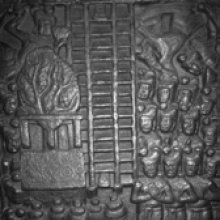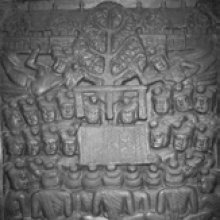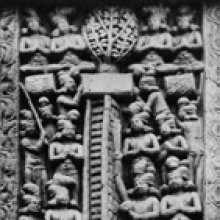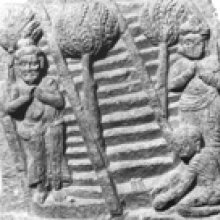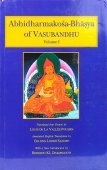Trayastrimsha, Trayastriṃśa, Trāyastriṃśa, Trayastrimsa, Trayas-trimsha: 13 definitions
Introduction:
Trayastrimsha means something in Buddhism, Pali, Jainism, Prakrit, Hinduism, Sanskrit. If you want to know the exact meaning, history, etymology or English translation of this term then check out the descriptions on this page. Add your comment or reference to a book if you want to contribute to this summary article.
The Sanskrit terms Trayastriṃśa and Trāyastriṃśa can be transliterated into English as Trayastrimsa or Trayastrimsha, using the IAST transliteration scheme (?).
Images (photo gallery)
In Buddhism
Mahayana (major branch of Buddhism)
Source: Wisdom Library: Maha Prajnaparamita SastraTrāyastriṃśa (त्रायस्त्रिंश) is part of the six groups of Gods inhabiting the Kāmadhātu (the first of the three worlds), according to the 2nd century Mahāprajñāpāramitāśāstra chapter 32-34. The six classes of gods of the desire realm (kāmadhātu), attached to the five desirable objects, will fall into the hells (niraya) and be subjected to all the sufferings.
The Trāyastriṃśa gods represents one of the seven destination of rebirths in kāmadhātu, according to chapter XLIX, “[...] another, of pure generosity and morality, honors his father and mother, reveres them (bhadanta) and passionately seeks supremacy (śreṣṭha): he is reborn among the Trāyastriṃśa gods”.
Source: academia.edu: A Study and Translation of the GaganagañjaparipṛcchāTrāyastriṃśa (त्रायस्त्रिंश) is the name of a Heaven, according to the Gaganagañjaparipṛcchā: the eighth chapter of the Mahāsaṃnipāta (a collection of Mahāyāna Buddhist Sūtras).—Accordingly, as Vimalaprabhānantaraśmirāja said to king Puṇyālaṃkāra: “[...] In this way, son of good family, when the rain of all kinds of jewels poured down from open space, the gods of the earth (bhauma), filled with admiration, said that this Bodhisattva is supposed to become the Gaganagañja. When such rain of all kinds of jewels poured down, just as the gods of the earth said, so the gods of the Cāturmahārājika heaven, the Trāyastriṃśa heaven, the Yāma heaven, the Tuṣita heaven, and the Nirmāṇarati heaven, filled with admiration, also said that this Bodhisattva is supposed to become the Gaganagañja. [...]”.

Mahayana (महायान, mahāyāna) is a major branch of Buddhism focusing on the path of a Bodhisattva (spiritual aspirants/ enlightened beings). Extant literature is vast and primarely composed in the Sanskrit language. There are many sūtras of which some of the earliest are the various Prajñāpāramitā sūtras.
General definition (in Buddhism)
Source: Google Books: Faith & philosophy of BuddhismThey are lower devas of the Kamadhatu who live on dissimilar parts of the mountain at the centre of the world, Sumeru. The Trayastrimsa devas, who live on the peak of Sumeru and are something like the Olympian Gods. Their ruler is Sakra.
Source: WikiPedia: BuddhismThe Trāyastriṃśa (Pāli: Tāvatiṃsa;) heaven is an important world of the devas in Buddhist cosmology. The word trāyastriṃśa is an adjective formed from the numeral trayastriṃśat, "33" and can be translated in English as "belonging to the thirty-three [devas]". It is primarily the name of the second heaven in Buddhist cosmology, and secondarily used of the devas who dwell there.
The Trāyastriṃśa heaven is the second of the heavens of the Kāmadhātu, and the highest of the heavens that maintains a physical connection with the rest of the world. Trāyastriṃśa is located on the peak of Sumeru, the central mountain of the world, at a height of 80,000 yojanas (a height sometimes equated to about 40,000 feet); the total area of the heaven is 80,000 yojanas square. This heaven is therefore comparable to the Greek Olympus in some respects.
According to Vasubandhu, inhabitants of Trāyastriṃśa are each half a krośa tall (about 1500 feet) and live for 1000 years, of which each day is equivalent to 100 years of our world: that is, for a total of 36 million of our years.
In Jainism
General definition (in Jainism)
Source: Wisdom Library: JainismTrāyastriṃśa (त्रायस्त्रिंश) or Trāyastriṃśaka.—One of the ten sub-types of gods (devas), according to Jain cosmology. The occupation of the trāyastriṃśas is to act as ministers or chaplains.
Source: archive.org: TrisastisalakapurusacaritraTrāyastriṃśa (त्रायस्त्रिंश) refers to one of the ten divisions of Gods, situated in the “upper World” (ūrdhvaloka), according to chapter 2.3 [ajitanātha-caritra] of Hemacandra’s 11th century Triṣaṣṭiśalākāpuruṣacaritra: an ancient Sanskrit epic poem narrating the history and legends of sixty-three illustrious persons in Jainism.—Accordingly:—“[...] The 10 divisions of the gods are: Indras, Sāmānikas, Trāyastriṃśas, Pārṣadyas, Rakṣakas, Lokapālas, Anīkas, Prakīrṇas, Ābhiyogikas, Kilbiṣikas. [....] The Trāyastriṃśas are like ministers and priests of Hari. [...] The Jyotiṣkas and Vyantaras do not have the Trāyastriṃśas and Lokapas”.
Source: Encyclopedia of Jainism: Tattvartha Sutra 4: The celestial beings (deva)Trāyastriṃśa (त्रायस्त्रिंश, “minister”) refers to one of the ten grades (ranks) of celestial beings (deva), according to the 2nd-century Tattvārthasūtra 4.4. These celestial beings (devas, gods) are of four orders /classes” and each class of celestial beings has ten grades (e.g., Trāyastriṃśa).
Who are called ministers (trāyastriṃśa)? The ministers are the elders like parents, teachers or preceptors. They are 33 in number. The ministers (trāyastriṃśa) and the custodians (lokapāla) do not exist in the peripatetic (vyantara) and stellar (jyotiṣī) celestial beings classes.

Jainism is an Indian religion of Dharma whose doctrine revolves around harmlessness (ahimsa) towards every living being. The two major branches (Digambara and Svetambara) of Jainism stimulate self-control (or, shramana, ‘self-reliance’) and spiritual development through a path of peace for the soul to progess to the ultimate goal.
Languages of India and abroad
Sanskrit dictionary
Source: DDSA: The practical Sanskrit-English dictionaryTrayastriṃśa (त्रयस्त्रिंश).—a. thirty-third.
Trayastriṃśa is a Sanskrit compound consisting of the terms trayas and triṃśa (त्रिंश).
Source: Cologne Digital Sanskrit Dictionaries: Edgerton Buddhist Hybrid Sanskrit DictionaryTrayastriṃśa (त्रयस्त्रिंश).—(compare prec.) = trāy°, q.v., in lists of Buddhist classes of gods: Mahāvastu iii.223.9 (prose, no v.l.); Divyāvadāna 68.12 (prose); 138.19; 367.10; 568.24; Avadāna-śataka 1.5.1 (prose); Suvarṇabhāsottamasūtra 86.9 (prose).
--- OR ---
Trāyastriṃśa (त्रायस्त्रिंश).—(compare Pali tāvatiṃsa, prec., and trayas- tri°), adj. with deva (q.v.) or subst., name of a class of Buddhist gods: Mahāvastu i.31.16 ff.; 40.15; 212.15 = ii.16.4; i.229.15; 262.1; 333.5; ii.163.11; 314.5; °śa- (v.l. °śe) bhavane Mahāvastu iii.302.8; °śe devanikāye iii.302.15; °śāḥ Mahāvyutpatti 3079; Dhar- mas 127. In other texts than Lalitavistara, Mahāvastu, the form trayas° seems more usual, while in Lalitavistara trāya-t° seems regular.
Source: Cologne Digital Sanskrit Dictionaries: Cappeller Sanskrit-English DictionaryTrayastriṃśa (त्रयस्त्रिंश).—[feminine] ri the thirty-third.
Source: Cologne Digital Sanskrit Dictionaries: Monier-Williams Sanskrit-English Dictionary1) Trayastriṃśa (त्रयस्त्रिंश):—[=trayas-triṃśa] [from trayas > traya] mf(ī)n. the 33rd, [Śatapatha-brāhmaṇa] ([dual number] ‘the 32nd and 33rd’, [iv, xi])
2) [v.s. ...] (chs. of [Mahābhārata] and, [Rāmāyaṇa])
3) [v.s. ...] + 33 [Śatapatha-brāhmaṇa xiii, 5, 4, 12 f.]
4) [v.s. ...] consisting of 33 parts (stoma, sometimes to be supplied), [Vājasaneyi-saṃhitā; Atharva-veda; Taittirīya-brāhmaṇa; Śatapatha-brāhmaṇa; Tāṇḍya-brāhmaṇa; Maitrī-upaniṣad]
5) [v.s. ...] numbering 33 (the gods), [Vājasaneyi-saṃhitā xx; Atharva-veda; Śatapatha-brāhmaṇa; Śāṅkhāyana-śrauta-sūtra iv]
6) [v.s. ...] celebrated with the śa Stoma, [Vājasaneyi-saṃhitā; Śatapatha-brāhmaṇa; Kātyāyana-śrauta-sūtra; Śāṅkhāyana-śrauta-sūtra]
[Sanskrit to German]
Sanskrit, also spelled संस्कृतम् (saṃskṛtam), is an ancient language of India commonly seen as the grandmother of the Indo-European language family (even English!). Closely allied with Prakrit and Pali, Sanskrit is more exhaustive in both grammar and terms and has the most extensive collection of literature in the world, greatly surpassing its sister-languages Greek and Latin.
See also (Relevant definitions)
Partial matches: Trimsha, Trayas.
Starts with: Trayastrimshacakravartin, Trayastrimshacakravartini, Trayastrimshachakravartin, Trayastrimshachakravartini, Trayastrimshadakshara, Trayastrimshadratra, Trayastrimshaka, Trayastrimshapati, Trayastrimshastoma, Trayastrimshat, Trayastrimshati, Trayastrimshatsammita, Trayastrimshavartani.
Full-text (+52): Trayastrimshavartani, Trayastrimshastoma, Trayastrimshapati, Trayastrimshaka, Caitraratha, Deva, Kovidara, Lokapala, Vyuhamati, Samkashya, Udakanishrita, Samcodaka, Pandukambalashila, Apajjura, Pandukambala, Citraratha, Pushkarini, Parushyaka, Lalitavyuha, Masakkasara.
Relevant text
Search found 28 books and stories containing Trayastrimsha, Trayas-triṃśa, Trayas-trimsa, Trayas-trimsha, Trayastriṃśa, Trāyastriṃśa, Trayastrimsa; (plurals include: Trayastrimshas, triṃśas, trimsas, trimshas, Trayastriṃśas, Trāyastriṃśas, Trayastrimsas). You can also click to the full overview containing English textual excerpts. Below are direct links for the most relevant articles:
Tattvartha Sutra (with commentary) (by Vijay K. Jain)
Verse 4.5 - Exceptions in the grades of celestial beings < [Chapter 4 - The Celestial Beings]
Verse 4.4 - Ten grades of celestial beings < [Chapter 4 - The Celestial Beings]
Maha Prajnaparamita Sastra (by Gelongma Karma Migme Chödrön)
Appendix 3 - Buddha’s sermon to the Trāyastriṃśa gods < [Chapter XLII - The Great Loving-kindness and the Great Compassion of the Buddhas]
Appendix 3 - Balance of power between the Devas and the Asuras < [Chapter XLVI - Venerating with the Roots of Good]
The Caturdevarājasūtra < [Section II.1 - Morality of the lay person or avadātavasana]
The Sacrifices of Rajasuya, Vajapeya and Ashvamedha (study) (by Aparna Dhar)
Details of the Sarvamedha Sacrifice < [Chapter 5 - Minor sacrifices and their Political Significance]
Ksitigarbha Bodhisattva fundamental vow sutra (by Johnny Yu)
Chapter 13 - Entrusting [the Deliverance] of Humans and Devas
Chapter 1 - Display of Divine Power in the Palace of the Trayastrimsas Heaven
Chapter 2 - The Assembly of Innumerable Emanations of Ksitigarbha Bodhisattva
The Mahavastu (great story) (by J. J. Jones)
Chapter III-e - Visit to other worlds (5): Thirty-three (trāyastriṃśa) < [Volume I]
Chapter XXVII - The goatherd’s banyan tree < [Volume III]
Chapter III-c - Visit to other worlds (3): Titans (asura) < [Volume I]
A Record of Buddhistic Kingdoms (by Fa-Hien)
Related products
